This article includes documentation of the so-called “Star Eater” issue with certain Sony cameras and long exposures of the night sky.
Update October, 2020:
According to multiple sources, including this video from Alan Stankevitz, the Sony a7SIII exhibits noticeable star eating noise reduction in its video mode at ISOs of 102400 and higher.
Update December, 2018:
With the discovery of a workaround, and improvement in the noise reduction algorithm in the Sony Mark III Alpha cameras (a7III and a7RIII), I have updated the title of this post and I have appended the content of my workaround post and elements of my a7III review to show what users can expect from these cameras. I still recommend Sony cameras for astrophotography, especially the new a7III and I still use the original a7S as my primary astrophotography camera. Those interested or concerned about the issue can read about how to avoid it here.
Documentation of the Problem
In 2016, Sony purportedly made firmware changes to their two flagship a7 series cameras (the a7RII and a7SII). The update (believed to be 3.30 on the a7RII and 2.10 on the a7SII) was supposed to include improvements for radio controlled lighting and overall camera stability and temperature control. But hidden in these improvements is a change that affects the image quality when shooting long exposures, particularly astrophotos. The problem has been dubbed “Star Eater” by others in the astro community. The issue also affected, from day one, the original line of a7 cameras when used in Bulb mode and the problem persists through out Sony’s latest line of cameras including the a9 and a7RIII.
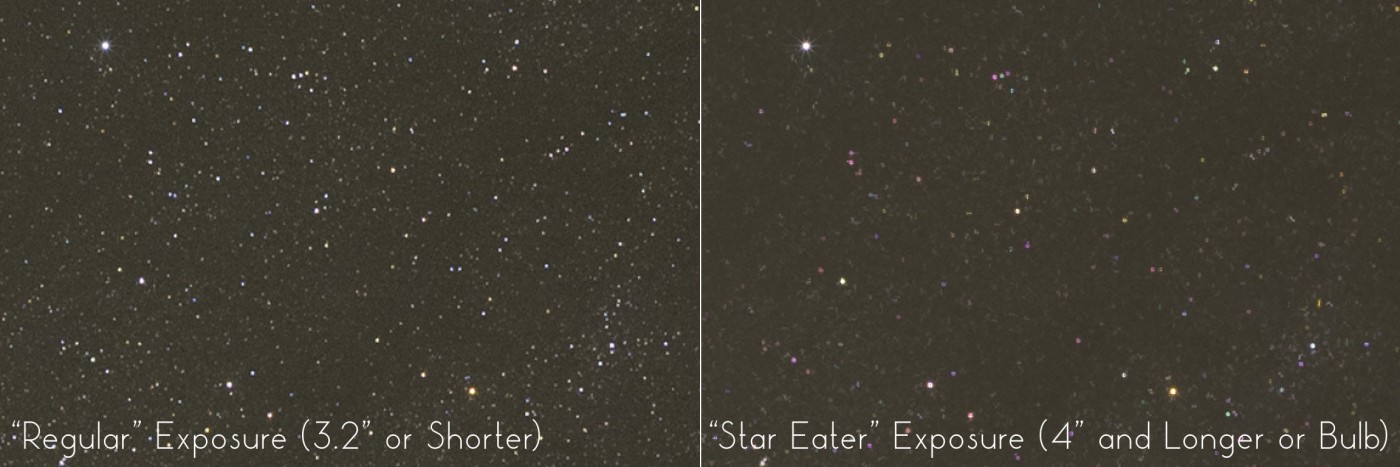
The “Star Eater” problem is a form of software spatial filtering designed to reduce noise in photos, particularly hot pixels. Unfortunately, the rather rudimentary filtering algorithm that Sony is using easily mistakes sharp pinpoint stars for noise, nearly deleting them from the image or greatly reducing their brightness. The result is an astrophoto with less stars and the appearance of diminished resolution. Sony a7RII, a7SII and a7RIII cameras exhibit this problem for all exposure times longer than 3.2″. Furthermore, the “Star Eater” issue affects RAW images (whether uncompressed or not) and cannot be disabled by any means. There are no user selectable settings that will prevent these cameras from eating stars.
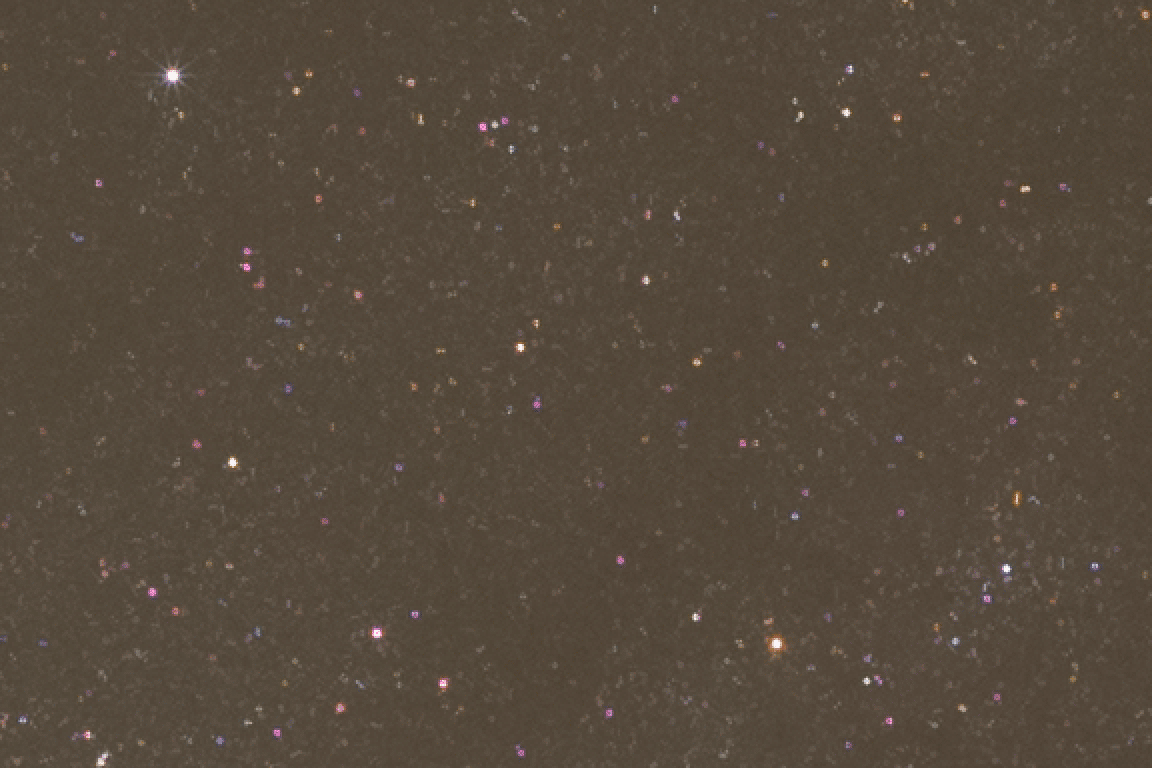
I have confirmed the issue myself and it has been discussed and analyzed many times on other places around the online photography community, particularly on the DPReview forums, Cloudy Nights, Jim Kasson’s Last Word, and more recently on Sony Alpha Rumors.
Bad spatial filtering isn’t new to Sony’s Alpha cameras. Even with the older firmware, all recent Sony alpha mirrorless cameras including the a6000, a6300, a6500, a7S, a7R, a7, a7II, a7SII and a7RII exhibit, in different ways, the “Star Eater” issue when using the Bulb exposure mode (my examples above are from the a7S in Bulb Mode). Untracked landscape astrophotography rarely requires exposures longer than 30″ so I found that the issue rarely affected my photography. (Most of my exposures are made between 5 and 20 seconds.)
The Workaround
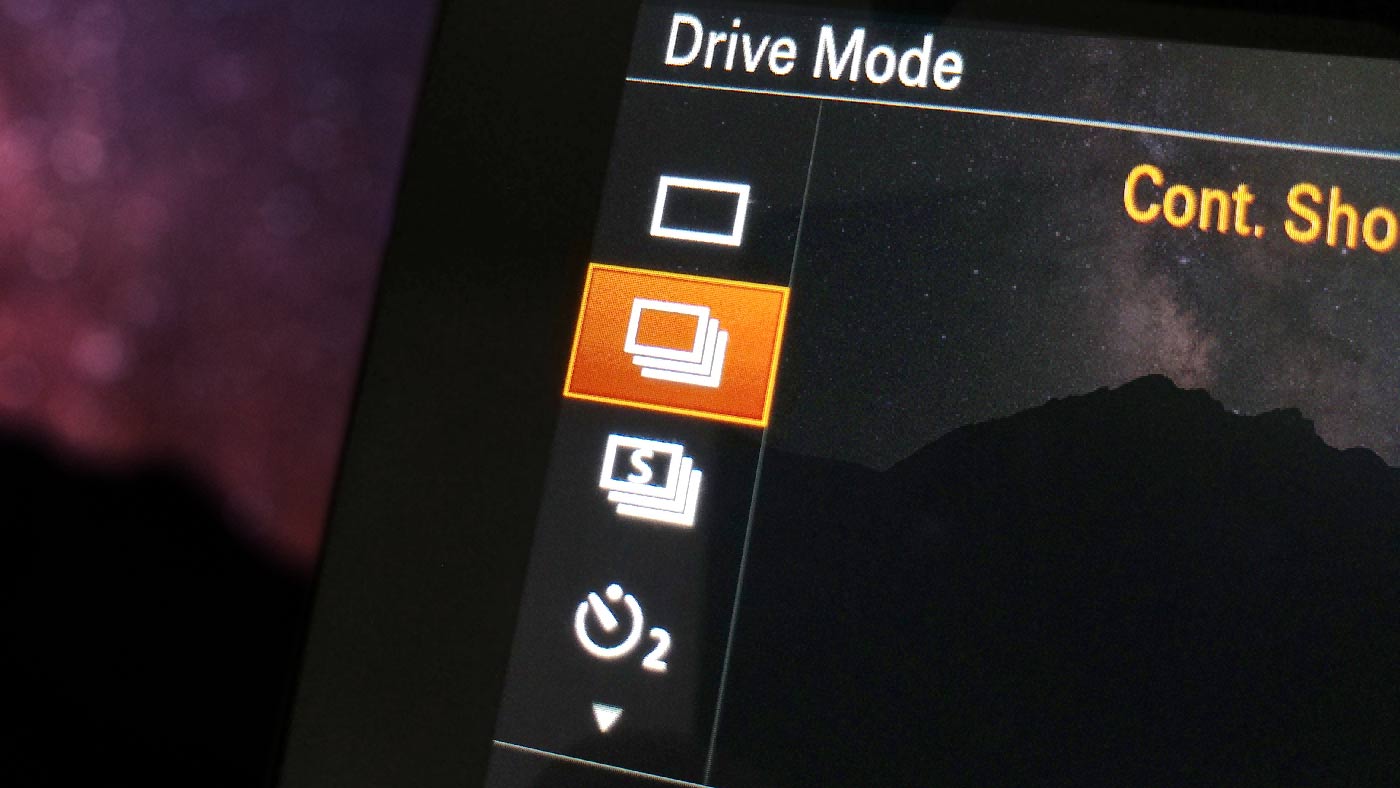
In a December 2017 post, Jim Kasson talked about a potential workaround on the a7RII. The fix is certainly counter-intuitive: enabling continuous drive mode while shooting long exposures. In his analysis, Jim shows that by enabling the continuous drive mode, the a7RII no longer exhibits the same behavior of the star-eating algorithm. Jim’s original analysis was only of the a7RII so I was curious to see if the same workaround would work on the a7SII. I had a friend supply some sample dark-frames from his a7SII and I took a close look at the files. Sure enough, enabling continuous mode seemed to prevent the star eater problem from occurring. I sent the frames to Jim for his final analysis of the a7SII star eater workaround which he has published here.
- So the good news: a7RII and a7SII users can circumvent the Sony star eater issue by shooting with continuous shutter mode enabled. Either regular “Continuous” or “Continuous Speed Priority” shutter modes will work.
- The bad news: by enabling continuous shutter mode, the color depth of the raw files is reduced to 12-bit. This means that the file is losing some dynamic range capability and may show some increase in noise. In all practicality, the results should be more desirable for astrophotography than the star-eaten files.
This workaround is a welcome find for owners of the a7RII and a7SII who enjoy shooting astrophotography but it’s still only a partial fix. Using the workaround, bit-depth is slightly reduced, limiting the dynamic range of the resulting photographs.
Should you care?
Maybe. I’ll admit that it is a problem that requires a fair bit of pixel peeping. Fellow landscape astrophotographer Michael Frye has made a great analysis of what you can expect from the a7RII. All told, some photographers might never even notice the issue. But as our community shifts more and more towards the enthusiast, to the photographer who really cares about the finest capability of their equipment, it’s an issue that I want to document.
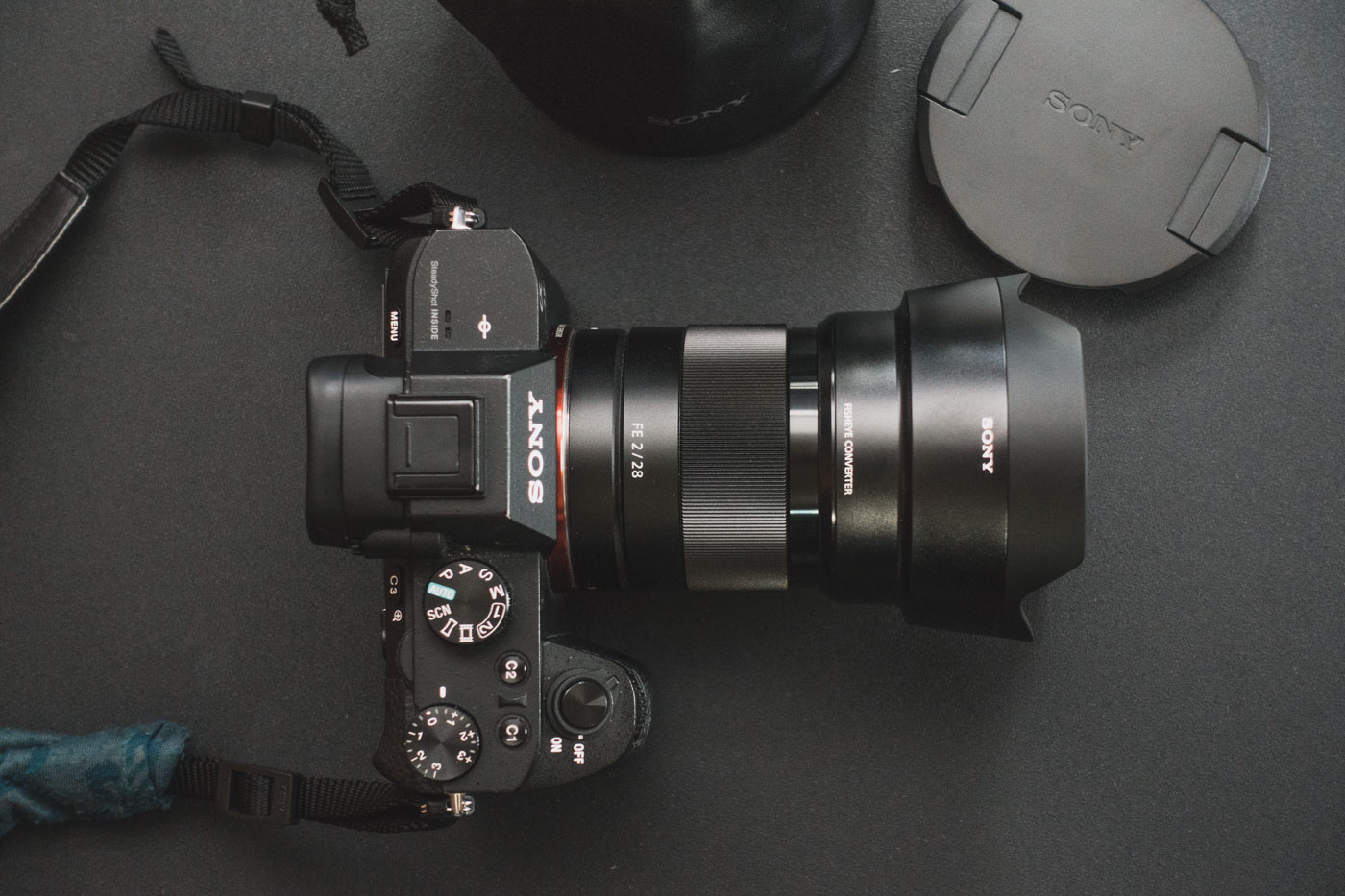
Without using the workaround, the a7SII in particular is affected very greatly by this issue because of its lower resolution sensor. It was a camera that launched with praise about its low light capability and now I highly discourage you use an a7SII for astrophotography. Want to know how each camera is affected by the issue? Here’s a summary of the differences between each camera and recommendations on how to deal with it:
- Sony a7
- Camera timed exposures up to 30s unaffected.
- Bulb exposures affected.
- Recommendation: Don’t shoot astrophotography with Bulb exposures.
- Sony a7R
- Camera timed exposures up to 30s unaffected.
- Bulb exposures affected.
- Recommendation: Don’t shoot astrophotography with Bulb exposures.
- This camera not recommended for tracked astrophotography.
- Sony a7S
- Camera timed exposures up to 30s unaffected.
- Bulb exposures affected.
- Because of the lower resolution sensor (12MP), star eater issue for Bulb exposures is significantly more apparent.
- Recommendation: Don’t shoot astrophotography with Bulb exposures.
- This camera not recommended for tracked astrophotography.
- Sony a7II
- Camera timed exposures up to 30s unaffected.
- Bulb exposures affected.
- Recommendation: Don’t shoot astrophotography with Bulb exposures.
- This camera not recommended for tracked astrophotography.
- Sony a7SII
- Camera timed exposures longer than 3.2s affected.
- Bulb exposures affected.
- Because of the lower resolution sensor (12MP), star eater issue is significantly more apparent.
- Recommendation: Use continuous shutter mode. Don’t shoot astrophotography with Bulb exposures.
- Sony a7RII
- Camera timed exposures longer than 3.2s affected.
- Bulb exposures affected.
- Continuous Low and High modes are a potential workaround, but with a reduction to 12-bit color depth.
- Recommendation: Use continuous shutter mode. The issue is mostly hidden by this camera’s higher resolution sensor. Don’t shoot astrophotography with Bulb exposures.
- Sony a9
- All timed exposures affected.
- Bulb exposures affected.
- Recommendation: Don’t shoot astrophotography with Bulb exposures. The issue can be partially hidden by this camera’s higher resolution sensor. Use longer than recommended exposure times to increase star trailing to reduce the effects of star eater.
- Sony a7RIII
- Camera timed exposures longer than 3.2s affected.
- Shows improvement over a7RII.
- Recommendation: The issue is mostly hidden by this camera’s higher resolution sensor. Use of long enough exposure times to increase star trailing will reduce the effects of star eater.
- Sony a7III
- Camera timed exposures longer than 3.2s affected.
- Shows improvement over previous generation
- Recommendation: The issue is mostly hidden by this camera’s higher resolution sensor and improved algorithm. Use of long enough exposure times to increase star trailing will reduce the effects of star eater.
Improvements in the Sony a7III
The below section is an excerpt from my a7III review.
The a7III exhibits a similar, but different characteristic noise filtering as previous generations. The filtering reduces noise and diminishes the brightness of small dim stars in an image for exposures of 4 seconds or longer. An easy way to see the effects of star-eater on the a7III is to simply compare a 3.2s exposure (left) with a 4s exposure (right):
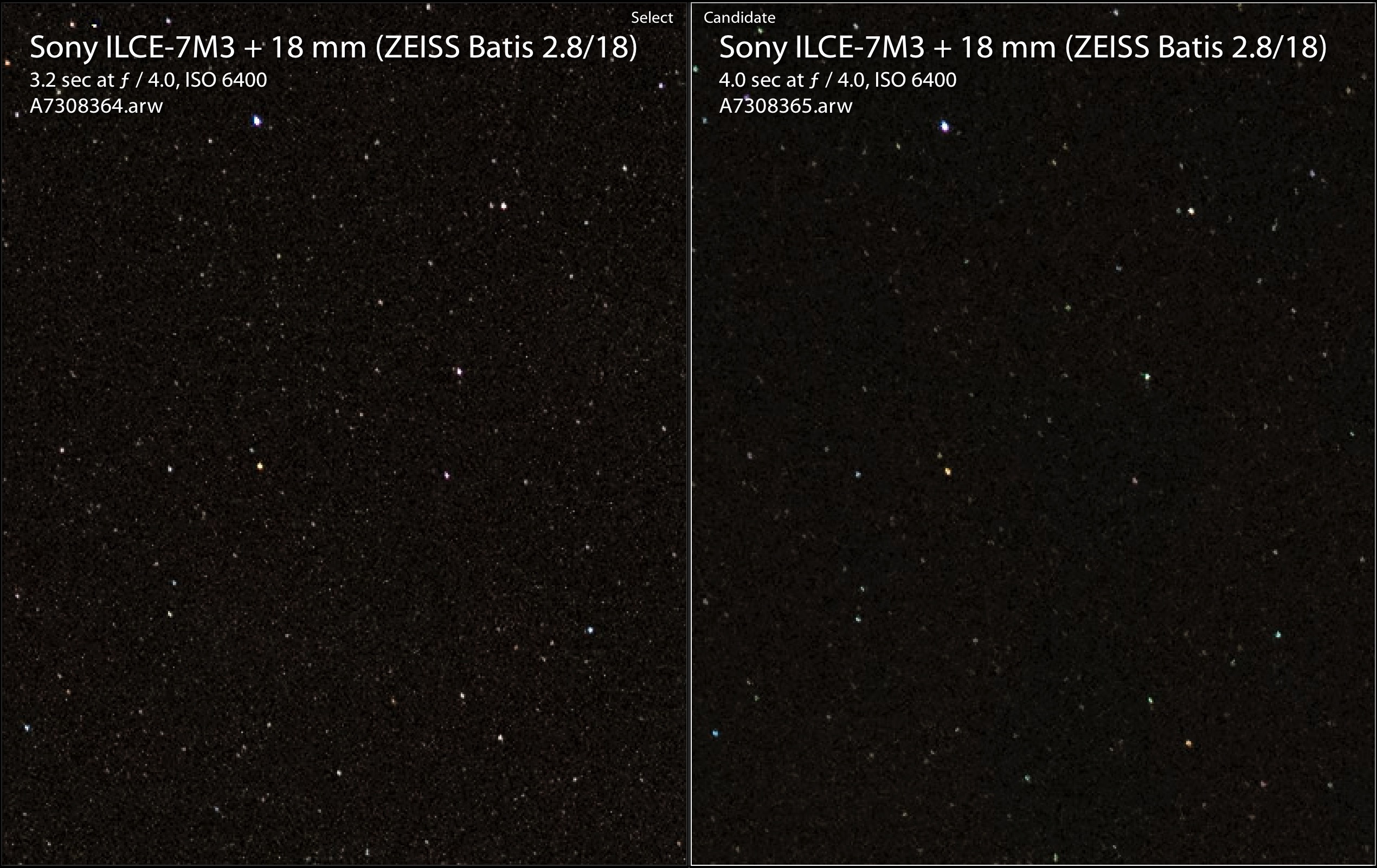
There’s definitely a difference in the 4 s exposure when compared to the 3.2 second exposure. At 4 seconds, noise is reduced dramatically and dim stars are further diminished in brightness, a clear indicator that Sony is filtering out the higher frequency noise and taking some stars with it. So star-eater is still present, but how does the problem compare with previous generations and how detrimental is it to actual shooting?
A 3.2 to 4 second exposure is a little short for most landscape astrophotos. Let’s take a look at a slightly more realistic 8 second exposure, compared with a previous generation camera that exhibits the star-eater issue (the a7S in Bulb-timed shooting mode). At 8 seconds long, on an 18mm lens, the stars should hopefully “burn-in” more and be less susceptible to the star-eater issue.
The comparison below shows an 8s star-eater exposure from the original generation a7S on the left (8s, Bulb-timed) versus a standard camera-timed 8s exposure from the a7III on the right. The a7S image was scaled to match for comparison purposes.
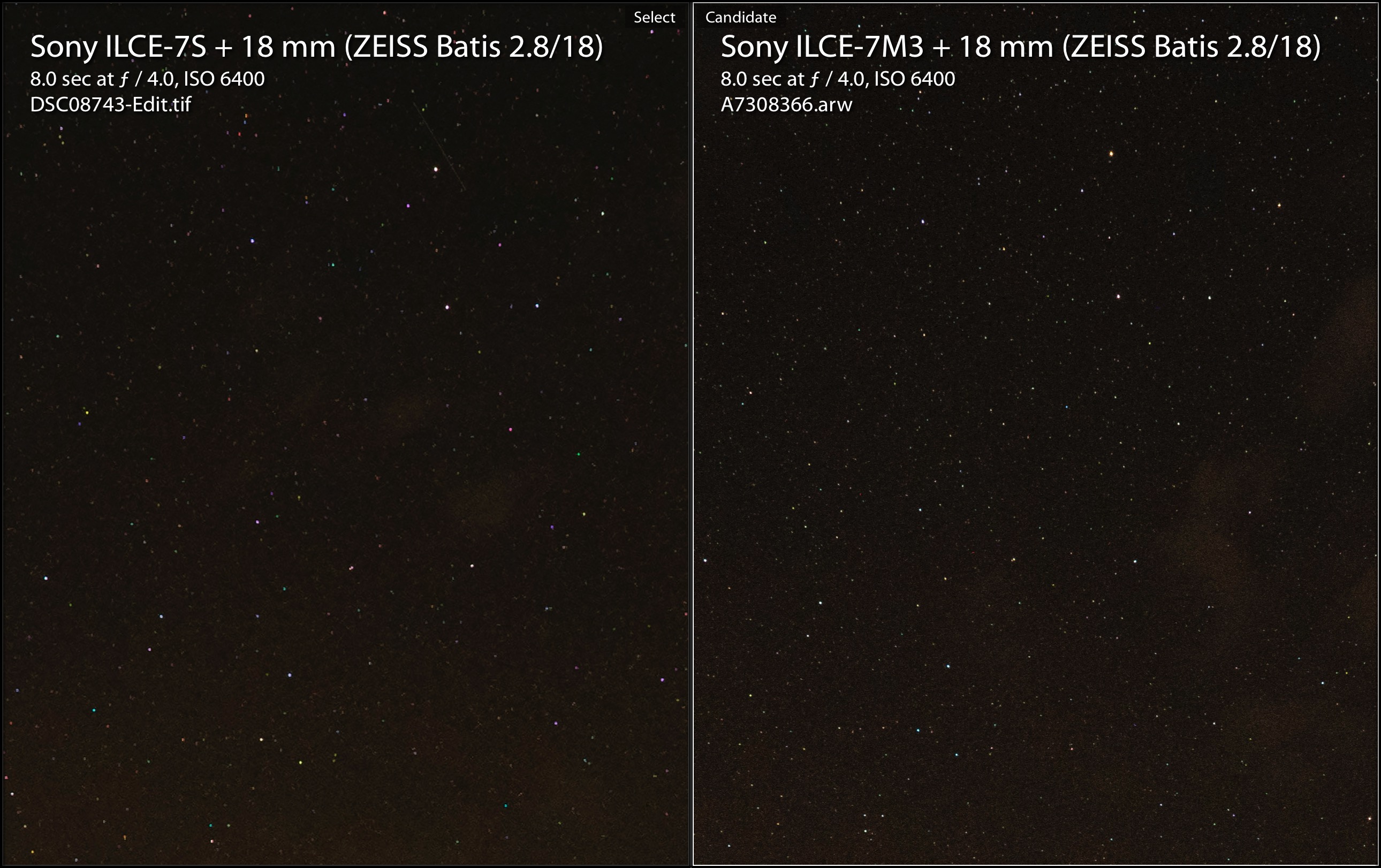
As you can see, the 8s a7III (right) shot looks a lot better than the star-eaten a7S Bulb shot (left). The a7S Bulb shot (left) shows some weird color shifted or blocky looking stars that appear a little bit defocused as a results of the old a7S’s spatial filtering (star-eater) in Bulb mode. The a7III shot shows more dim stars and stars appear markedly sharper than in the old a7S Bulb shot. Stars look “normal” in the a7III shot. This result is great news for astrophotographers looking to get the a7III.
If we compare details from that same 8s image from the a7III with an 8s non-star-eater (camera-timed) image from the a7S, differences become significantly less noticeable. The a7S image was scaled to match for comparison purposes.
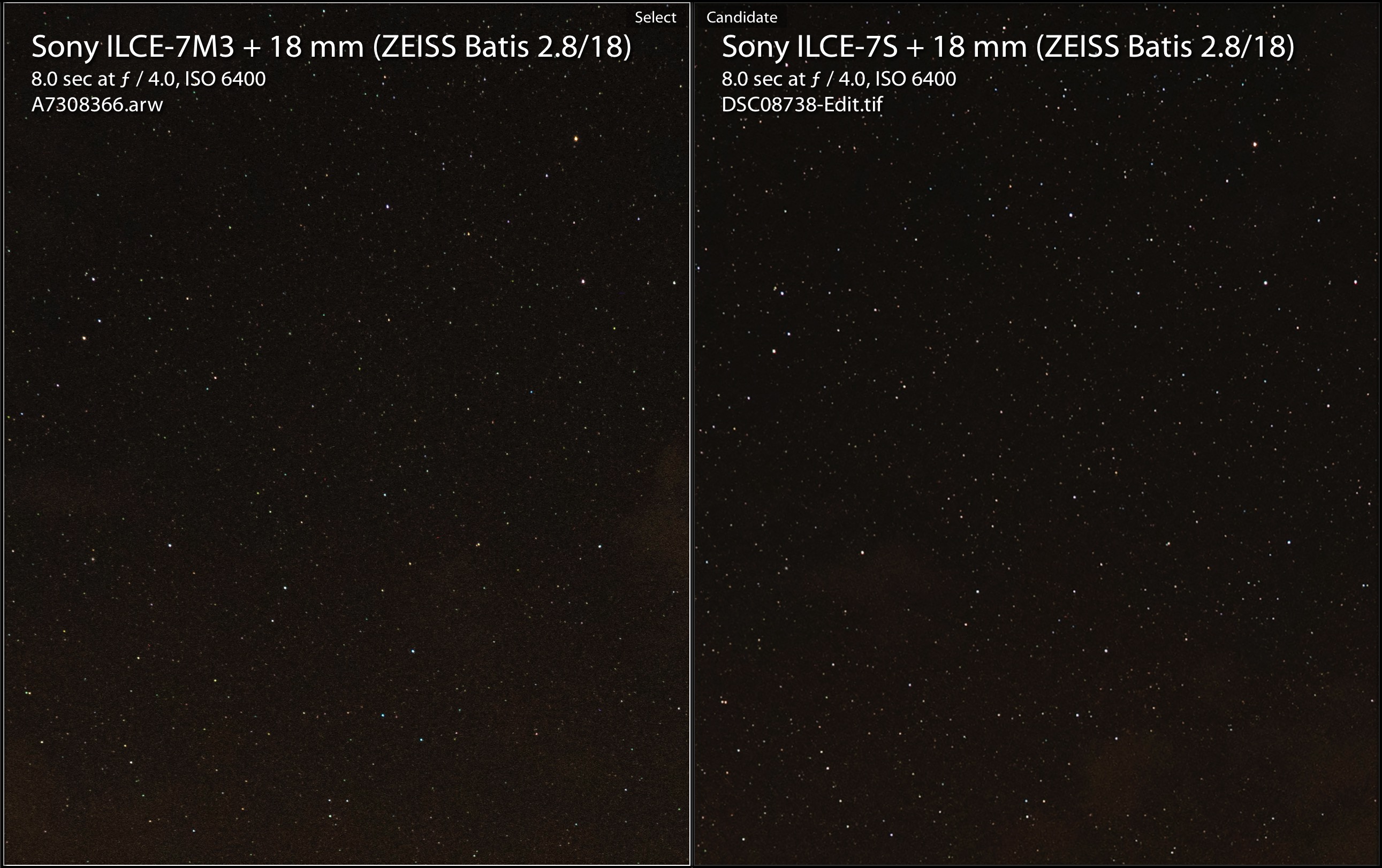
Here, both the a7III (left) and a7S (right) seem to be on par with each other in this direct 8S exposure comparison. The frequency and sharpness of stars look pretty much the same between both images. Upon very close inspection, I’d probably give the original a7S a very slight advantage in terms of noise but both cameras seem to do a good job at resolving fine stars.
So, there’s still some noise filtering in the Sony a7III, but in practice, it’s much improved from previous generations. Sony has obviously tweaked their noise algorithm a bit and the result is much more acceptable for typical night photography exposures. The a7III’s higher resolution sensor, when compared to the a7S probably also helps here. While star-eater is improved, it doesn’t hide the fact that the Sony is still doing some funky stuff to the a7III long exposure RAWs.
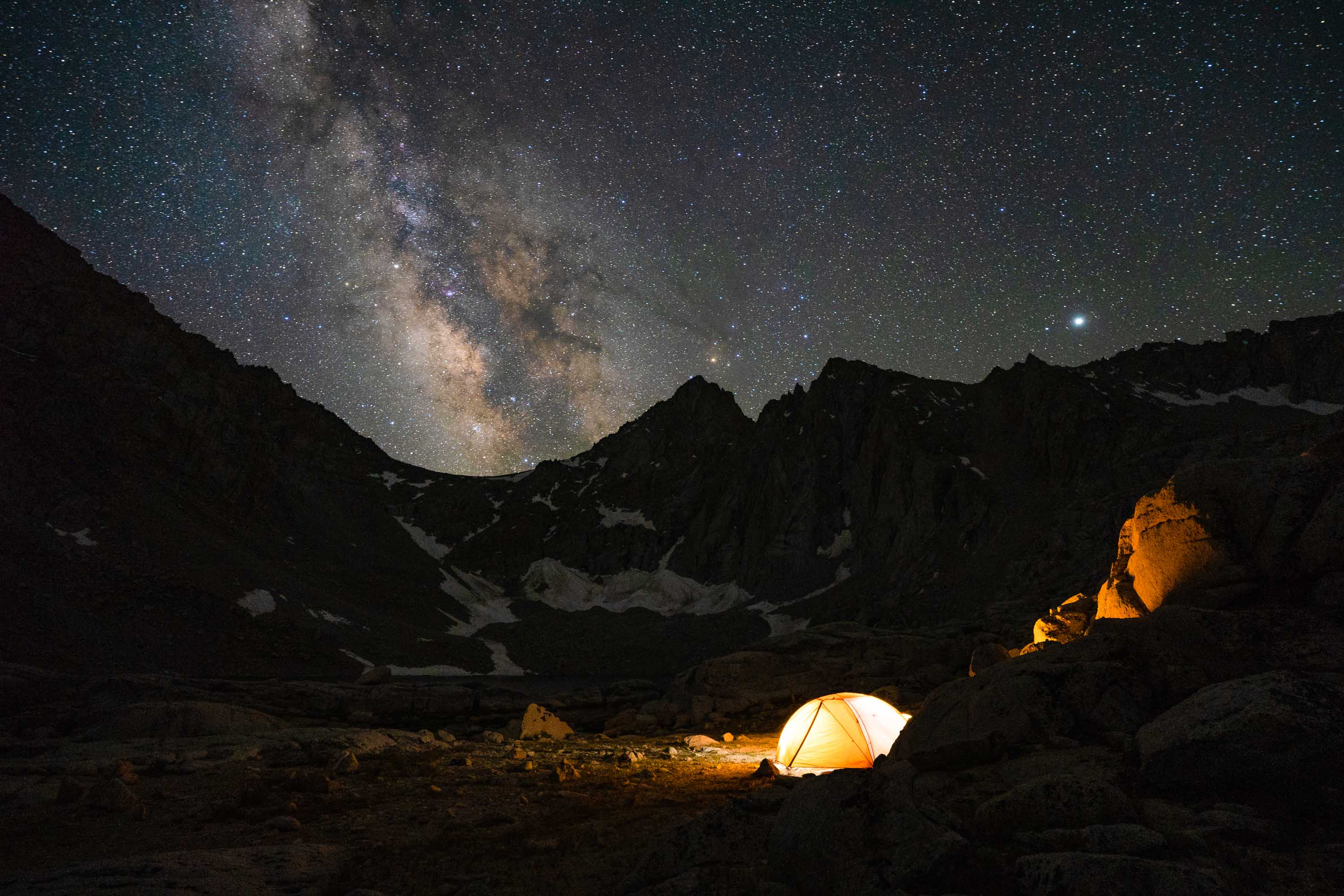
We wish that Sony did not apply a noise reduction algorithm as such to the a7III’s RAW files. RAW should be raw, unfiltered and un-baked. Ultimately, however, we really love most of the astrophotos that we’ve made from the a7III and we think that they speak for themselves.
References
For reference, here are a number of online sources that discuss the “Star Eater” problem:
DPReview:
https://www.dpreview.com/forums/post/58709160
https://www.dpreview.com/forums/post/55841466
Cloudy Nights:
https://www.cloudynights.com/topic/498339-sony-a7s-star-eater-algorithm/
https://www.cloudynights.com/topic/505754-another-real-world-example-of-sonys-star-eater-problem/
https://www.cloudynights.com/topic/558230-star-eater-in-action-sony-a7rii/
SAR:
http://www.sonyalpharumors.com/specific-a7sii-astrophotography-fix-request/#disqus_thread
Sony Community:
https://community.sony.com/t5/Alpha-NEX-Cameras/Star-eater-in-bulb-mode/td-p/508740
From Jim Kasson:
http://blog.kasson.com/the-last-word/spacial-filtering-of-raw-images-by-sony-a7s-a7ii/
http://blog.kasson.com/the-last-word/sony-a7rii-long-exposure-spatial-filtering-with-fw-3-30/
http://blog.kasson.com/the-last-word/16486/
http://blog.kasson.com/the-last-word/lenr-and-sony-a7rii-fw-3-30-lowpass-filteering/
http://blog.kasson.com/the-last-word/reverse-engineering-the-sony-a7rii-long-exposure-spatial-filtering/
http://blog.kasson.com/the-last-word/sony-a7rii-bulb-spatial-filtering/
Jim Kasson has written about a possible workaround on the a7RII by using “Continuous High or Continuous Low” modes.
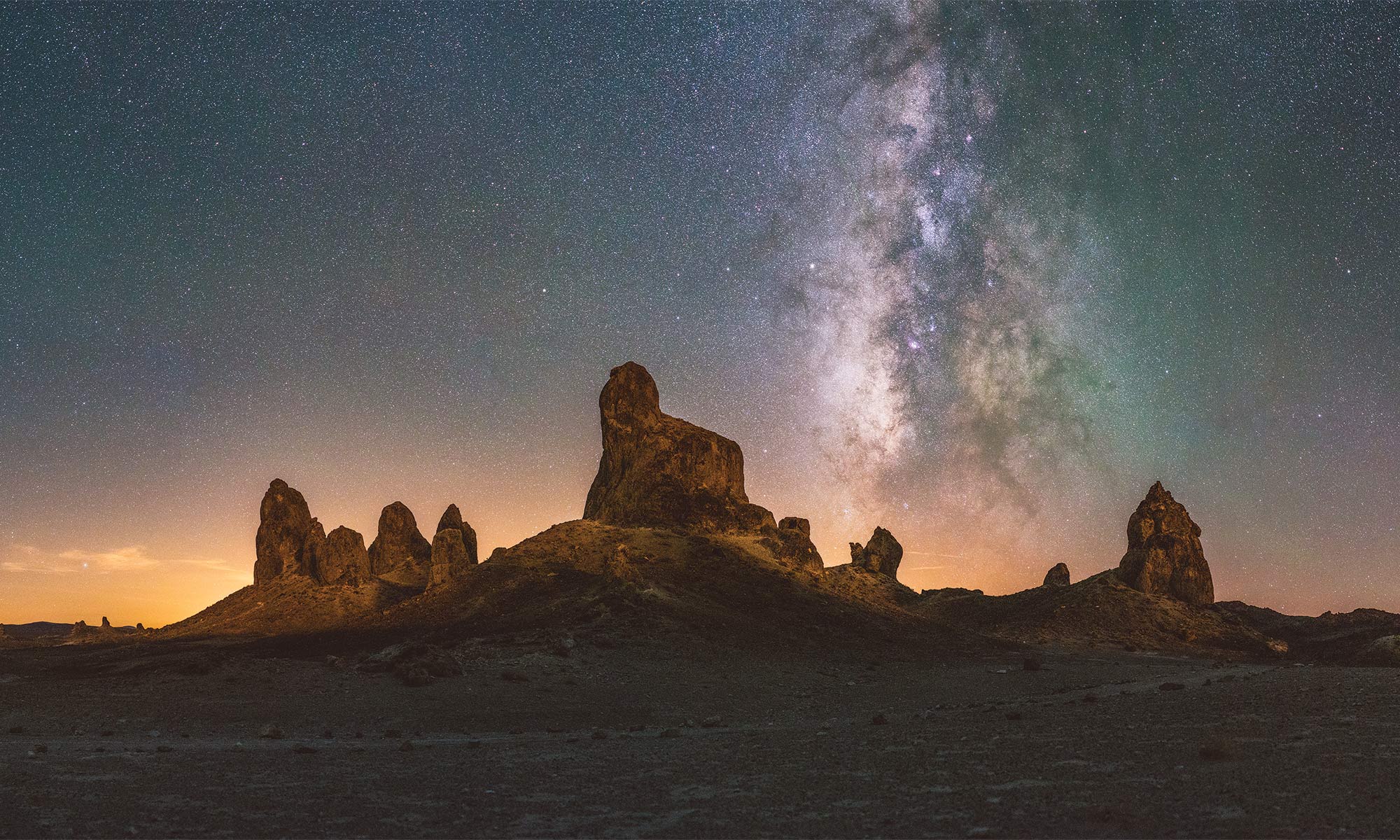
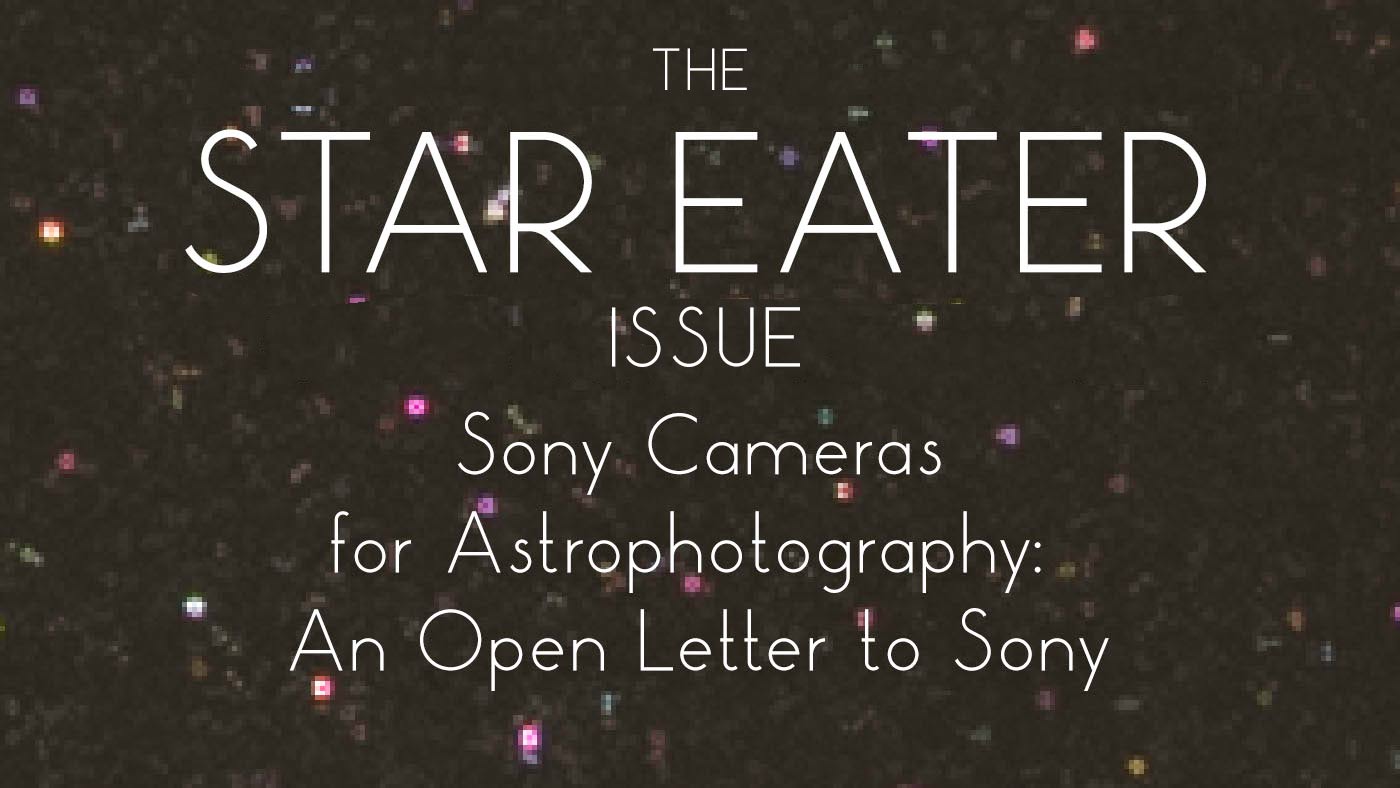
hey Ian,
Out of curiosity… Have you pulled the tiff file out one of the raw files yet?
It would be interesting to see if the “data tiff” inside the raw file is ok and its stars haven’t been eaten. That file should be bare-boned with no exif or settings embedded. In other words, it would show if Sony is truly writing a true, untouched raw file or not.
I believe in theory the inner tiff should be uneaten and the eater is in the data setting files inside the raw container. If they’re fine it’d be great but you’d lose the exif data (as a workaround) but still could add some back but at least you could still use the photos.
How is that done? I would absolutely do that.
I don’t think that is a thing. There is an embedded jpeg preview but not a tiff. All testing done on Sony files affected by star-eater seem to indicated spatial filtering is being applied.
@don… I use a program called file juicer… just drop a file on it and it spits out all the parts
@Ian, I can pull them out of my sony files(nikon and canon too), I just don’t have any astro shots from my older sony.
from the wiki page
“Many raw file formats, including IIQ (Phase One), 3FR (Hasselblad), DCR, K25, KDC (Kodak), CR2 (Canon), ERF (Epson), MEF (Mamiya), MOS (Leaf), NEF (Nikon), ORF (Olympus), PEF (Pentax), RW2 (Panasonic) and ARW, SRF, SR2 (Sony), are based on the TIFF file format”
“Sony files affected by star-eater seem to indicated spatial filtering is being applied.”
The question is… is it being applied to the actual raw image (tiff) or is it doing it in the header or data file in the raw package.
it’s worth checking, you have my email if you want to send me a raw. I’ll send you back the parts.
I noticed that File Juicer is a Mac-only program. Do you know of a Windows equivalent? I don’t know which OS Ian uses, but since he’s from an engineering background, it’s very likely he’s more familiar with Windows since practically all engineering programs are Windows-only affairs.
KENNY LE, I have no idea, I haven’t owned a windows machine in about 16 years.
@kennylee
I think there’s something similar to filejuicer
It’s called Bitmap rip
Was reading it sometime back…
Let us all know if you guys reach a conclusion on this!! Please 🙂
Ian, it looks like a new firmware has been released for Sony’s mirrorless Alpha cameras. Can you verify that this firmware update (v3.0) solves the star eater problem on the Sony A7SII?
V3.0 and V4.0 does NOT fix the star eater issue.
Unfortunately, little if anything has changed in regards to star-eater problems in the v3.0 (a7SII) and v4.0 (a7RII) firmware versions.
Does anyone know if this “star eater” fiasco is inherent in the A7 mk 2 model affecting it in bulb mode only or is now affected with a 4 seconds or greater exposure with the new firmware?
As per my information, the new firmware did not fix the “star eater issue”. Its effected in A7mk2, A7Rmk2, A7Smk2 in +3.2 sec and Bulb mode. Also Effected A7S, A7R, A7 in Bulb mode only.
I own the original A7S, I can only confirm its effected in bulb mode, I don’t own others to test/confirm.
Please refer to the following threads for more info;
https://www.dpreview.com/forums/thread/4168505
https://www.dpreview.com/forums/thread/4167521
We still hope for Sony to fix all the models Mark1 and Mark2. I’ve heard the new A9 cameras are effected with star eater as well.
In the latest firmware, it is now inherent for all exposures 4 seconds or longer, even when not using bulb.
Are you sure this is also true for the A7II (not SII / RII)?
Hi Ian, Can you tell me if the Sony a99ii camera is effected by the star eater firmware problem?
Thanks,
Geoff.
Hi Ian, Do you know if the star eater problem effects the Sony a99ii camera?
This saved me a lot of disappointment and money… but your website still recommends Sony cameras:
https://www.lonelyspeck.com/beginner-astrophotography-kit/